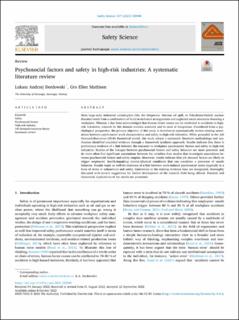| dc.contributor.author | Derdowski, Lukasz Andrzej | |
| dc.contributor.author | Mathisen, Gro Ellen | |
| dc.date.accessioned | 2023-03-30T13:46:30Z | |
| dc.date.available | 2023-03-30T13:46:30Z | |
| dc.date.created | 2023-03-15T11:04:19Z | |
| dc.date.issued | 2022 | |
| dc.identifier.citation | Derdowski, L. A., & Mathisen, G. E. (2023). Psychosocial factors and safety in high-risk industries: a systematic literature review. Safety science, 157, 105948. | en_US |
| dc.identifier.issn | 0925-7535 | |
| dc.identifier.uri | https://hdl.handle.net/11250/3061227 | |
| dc.description.abstract | Most large-scale industrial catastrophes (like the Deepwater Horizon oil spill, or Fukushima-Daiichi nuclear disaster) result from a combination of faults in technical arrangements and neglected social structures featuring a workplace. Whereas it has been acknowledged that human-factor causes can be attributed to accidents in high-risk industries, research in this domain remains scattered and in need of integration. Considered from a psychological perspective, the primary objective of this study is therefore to systematically review existing associations between psychosocial work characteristics and safety in high-risk industries. While grounded in the Job Demands-Resources (JD-R) theoretical model, this study adopts a systematic literature methodology and synthesizes identified empirical evidence through a framework synthesis approach. Results indicate that there is preliminary evidence of a link between the exposure to workplace psychosocial factors and safety in high-risk industries. Studies of the linkages between psychosocial factors and safety behavior are more prevalent and do more often find significant associations between the variables than studies that investigate associations between psychosocial factors and safety outputs. Moreover, results indicate that job demand factors are likely to trigger employees’ health-impairing mental/physical conditions that can constitute a precursor of unsafe behavior. Results imply as well the existence of a link between work-induced psychosocial states (typically in a form of stress or exhaustion) and safety. Limitations in the existing evidence base are recognized, thoroughly discussed with several suggestions for further development of the research field being offered. Practical and theoretical implications of the results are presented. | en_US |
| dc.language.iso | eng | en_US |
| dc.publisher | Elsevier | en_US |
| dc.relation.uri | https://www.sciencedirect.com/science/article/pii/S0925753522002879?via%3Dihub | |
| dc.rights | Navngivelse 4.0 Internasjonal | * |
| dc.rights.uri | http://creativecommons.org/licenses/by/4.0/deed.no | * |
| dc.title | Psychosocial factors and safety in high-risk industries: a systematic literature review | en_US |
| dc.type | Peer reviewed | en_US |
| dc.type | Journal article | en_US |
| dc.description.version | publishedVersion | en_US |
| dc.rights.holder | The authors | en_US |
| dc.subject.nsi | VDP::Samfunnsvitenskap: 200 | en_US |
| dc.source.volume | 157 | en_US |
| dc.source.journal | Safety Science | en_US |
| dc.identifier.doi | 10.1016/j.ssci.2022.105948 | |
| dc.identifier.cristin | 2134053 | |
| cristin.ispublished | true | |
| cristin.fulltext | original | |
| cristin.qualitycode | 2 | |

